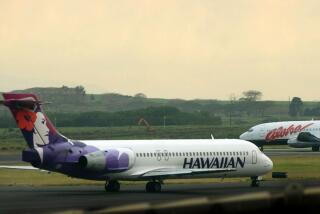United Gets OK to Buy Pan Am’s Pacific Division
WASHINGTON — Transportation Secretary Elizabeth Hanford Dole has given final approval for the largest airline deal in history, the purchase by United Airlines of the historic Pacific Division of Pan American World Airways, the Transportation Department announced today.
United Airlines immediately said it was “highly gratified” over the decision and announced it plans to buy $3-billion worth of new aircraft from the Boeing Co. as part of a fleet expansion that the company said will meet its needs into the 1990s.
The purchase from Boeing is the largest single aircraft order in United’s history and covers 110 short-range Boeing 737-300s and six Boeing 747s to be delivered over the next five years.
The $715-million sale of Pan Am’s operations over the Pacific to United already had been approved tentatively by Dole early last month, and apparently she was not swayed by arguments since then by the Justice Department and a number of airlines that the United-Pan Am deal would be anti-competitive.
More Routes Forthcoming
“United will confront a more competitive market when this transaction is completed than exists today,” Dole said in a statement. She also noted that under a U.S.-Japan air agreement signed earlier this year, additional U.S. carriers will be given Pacific routes in the coming months, producing additional competition.
The decision was sent to the White House late last week, officials said.
President Reagan has 60 days in which he could reverse the decision, but government sources said that was unlikely since he may only do so on narrow “foreign relations or national defense” grounds and not on economic or competitive arguments.
United still must negotiate landing rights from Japan and other countries involved, a process that industry sources said might become a roadblock if Japan seeks to use the issue as leverage to increase its aviation presence in the United States.
The deal makes United the country’s largest domestic airline and gives it its first major presence in the international airline market with a route system that stretches from the West Coast to Tokyo.
For Pan Am, the deal meant giving up a route that is steeped in aviation history. Pan Am pioneered the Pacific skies with its “China Clipper” in the 1930s and marked the first U.S. commercial aviation presence in many Asian countries.
More to Read
Inside the business of entertainment
The Wide Shot brings you news, analysis and insights on everything from streaming wars to production — and what it all means for the future.
You may occasionally receive promotional content from the Los Angeles Times.









